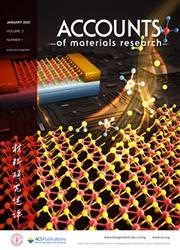Material Hunting of Advanced Metal Oxide Films for Electro- and Photoelectrocatalysis Using a Mixed Metal-Imidazole Casting (MiMIC) Method
IF 14
Q1 CHEMISTRY, MULTIDISCIPLINARY
引用次数: 0
Abstract
Electrochemical and photoelectrochemical conversion of renewable energy sources into useful chemicals and fuels is of paramount importance for future sustainable technologies. Renewable energy conversion requires catalysts for multielectron redox reactions such as water oxidation and reduction (toward water splitting systems). Developing efficient catalysts for multielectron redox reactions is a great challenge in current science and technology. Metal oxides have been extensively researched to be applied to a large variety of photonic and electronic devices due to the wide range of electronic properties of conducting, semiconducting, and insulating and diverse catalytic properties at their surface depending on the exposing facet, as well as physical and chemical robustness under ambient conditions. We aspire to the development of an easy technique available for large-scale production of metal oxide films based on simple casting and calcination to adopt a strategy for controlling the formation and growth of metal oxide films by ligands to metal centers in precursors. We have developed an easy preparation technique of mono- and multimetallic oxide films, termed the “mixed metal-imidazole casting (MiMIC) method”, by which metal oxide films are generated tightly on various electrode substrates by casting precursor solutions or suspensions containing component metal salts in a mixed solvent of methanol/imidazole derivative as a ligand, followed by calcination. The general versatility of the MiMIC method encourages us to hunt new metal oxide films as efficient catalysts for the multielectron redox reactions, because the rigid adherability of films formed on a current collector electrode is necessary for essential evaluation of the catalytic performance of the metal oxide films. In this Account, we expound synthesis and characterization of a variety of mono- and multimetallic oxide films using the MiMIC method and its application to electro- and photoelectrocatalysis for water splitting and oxygen reduction, which are important key reactions in future sustainable technology. The adherability of these films onto the electrode surface is prominent although their morphology, crystallinity, and nanostructures depend on the metal oxide materials, which is one of the important factors to induce high performance of the metal oxide films for electro- and photoelectrocatalysis. Imidazole derivatives were found to act as a source of nitrogen for the N-doping to a metal oxide lattice, and a structure-directing agent for the anisotropic crystallization, as well as a binder among constituting nanoparticles to lead to the rigid adherability of films on the substrate. These findings surely expand material development to a great extent, by not only changing the metal compositions but also being based on band engineering due to doping of representative elements and crystal facet control of metal oxide films.

利用混合金属-咪唑浇铸法 (MiMIC) 制备用于电催化和光电催化的先进金属氧化物薄膜的材料猎取技术
将可再生能源转化为有用的化学品和燃料的电化学和光电化学过程对未来的可持续技术至关重要。可再生能源转换需要多电子氧化还原反应催化剂,如水氧化和还原(用于水分离系统)。开发高效的多电子氧化还原反应催化剂是当前科学和技术领域面临的巨大挑战。金属氧化物具有导电、半导电和绝缘等多种电子特性,其表面的催化特性因暴露面而异,而且在环境条件下具有物理和化学稳定性,因此被广泛应用于各种光子和电子设备。我们希望在简单铸造和煅烧的基础上,开发出一种可用于大规模生产金属氧化物薄膜的简便技术,采用一种通过前驱体中金属中心的配体来控制金属氧化物薄膜的形成和生长的策略。我们开发了一种简便的单金属和多金属氧化物薄膜制备技术,称为 "混合金属-咪唑浇铸(MiMIC)法",通过在甲醇/咪唑衍生物作为配体的混合溶剂中浇铸含有组分金属盐的前驱体溶液或悬浮液,然后进行煅烧,在各种电极基底上紧密生成金属氧化物薄膜。MiMIC 方法的通用性鼓励我们寻找新的金属氧化物薄膜作为多电子氧化还原反应的高效催化剂,因为在集流电极上形成的薄膜的刚性附着性是评估金属氧化物薄膜催化性能的必要条件。在本报告中,我们阐述了利用 MiMIC 方法合成和表征各种单金属和多金属氧化物薄膜,并将其应用于电催化和光电催化的水分离和氧还原反应,这些反应是未来可持续发展技术的重要关键反应。虽然这些薄膜的形态、结晶度和纳米结构取决于金属氧化物材料,但它们在电极表面的附着性非常突出,这是促使金属氧化物薄膜在电催化和光催化中发挥高性能的重要因素之一。研究发现,咪唑衍生物可作为金属氧化物晶格中 N 掺杂的氮源、各向异性结晶的结构引导剂,以及构成纳米颗粒的粘合剂,从而使薄膜在基底上具有刚性附着性。这些发现不仅改变了金属成分,还通过掺杂代表性元素和控制金属氧化物薄膜的晶面,实现了能带工程,从而在很大程度上拓展了材料开发领域。
本文章由计算机程序翻译,如有差异,请以英文原文为准。
求助全文
约1分钟内获得全文
求助全文

 求助内容:
求助内容: 应助结果提醒方式:
应助结果提醒方式:


